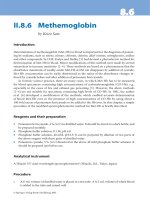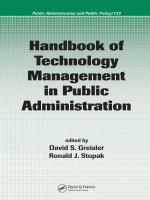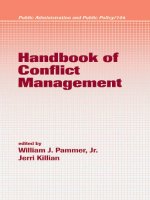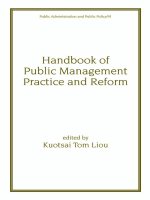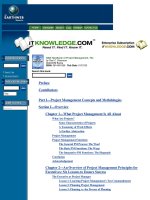Handbook of construction management scope schedule and cost control
Bạn đang xem bản rút gọn của tài liệu. Xem và tải ngay bản đầy đủ của tài liệu tại đây (13.7 MB, 806 trang )
HANDBOOK OF
CONSTRUCTION
MANAGEMENT
Scope, Schedule, and Cost Control
www.ebook3000.com
Industrial Innovation Series
Series Editor
Adedeji B. Badiru
Air Force Institute of Technology (AFIT) – Dayton, Ohio
PUBLISHED TITLES
Carbon Footprint Analysis: Concepts, Methods, Implementation, and Case Studies,
Matthew John Franchetti & Defne Apul
Cellular Manufacturing: Mitigating Risk and Uncertainty, John X. Wang
Communication for Continuous Improvement Projects, Tina Agustiady
Computational Economic Analysis for Engineering and Industry, Adedeji B. Badiru &
Olufemi A. Omitaomu
Conveyors: Applications, Selection, and Integration, Patrick M. McGuire
Culture and Trust in Technology-Driven Organizations, Frances Alston
Design for Profitability: Guidelines to Cost Effectively Management the Development Process
of Complex Products, Salah Ahmed Mohamed Elmoselhy
Global Engineering: Design, Decision Making, and Communication, Carlos Acosta, V. Jorge Leon,
Charles Conrad, & Cesar O. Malave
Global Manufacturing Technology Transfer: Africa–USA Strategies, Adaptations, and Management,
Adedeji B. Badiru
Guide to Environment Safety and Health Management: Developing, Implementing, and
Maintaining a Continuous Improvement Program, Frances Alston & Emily J. Millikin
Handbook of Construction Management: Scope, Schedule, and Cost Control,
Abdul Razzak Rumane
Handbook of Emergency Response: A Human Factors and Systems Engineering Approach,
Adedeji B. Badiru & LeeAnn Racz
Handbook of Industrial Engineering Equations, Formulas, and Calculations, Adedeji B. Badiru &
Olufemi A. Omitaomu
Handbook of Industrial and Systems Engineering, Second Edition, Adedeji B. Badiru
Handbook of Military Industrial Engineering, Adedeji B. Badiru & Marlin U. Thomas
Industrial Control Systems: Mathematical and Statistical Models and Techniques,
Adedeji B. Badiru, Oye Ibidapo-Obe, & Babatunde J. Ayeni
Industrial Project Management: Concepts, Tools, and Techniques, Adedeji B. Badiru,
Abidemi Badiru, & Adetokunboh Badiru
Inventory Management: Non-Classical Views, Mohamad Y. Jaber
Kansei Engineering—2-volume set
•
Innovations of Kansei Engineering, Mitsuo Nagamachi & Anitawati Mohd Lokman
•
Kansei/Affective Engineering, Mitsuo Nagamachi
Kansei Innovation: Practical Design Applications for Product and Service Development,
Mitsuo Nagamachi & Anitawati Mohd Lokman
Knowledge Discovery from Sensor Data, Auroop R. Ganguly, João Gama, Olufemi A. Omitaomu,
Mohamed Medhat Gaber, & Ranga Raju Vatsavai
Learning Curves: Theory, Models, and Applications, Mohamad Y. Jaber
Managing Projects as Investments: Earned Value to Business Value, Stephen A. Devaux
Modern Construction: Lean Project Delivery and Integrated Practices, Lincoln Harding Forbes &
Syed M. Ahmed
PUBLISHED TITLES
Moving from Project Management to Project Leadership: A Practical Guide to Leading Groups,
R. Camper Bull
Project Management: Systems, Principles, and Applications, Adedeji B. Badiru
Project Management for the Oil and Gas Industry: A World System Approach, Adedeji B. Badiru &
Samuel O. Osisanya
Project Management for Research: A Guide for Graduate Students, Adedeji B. Badiru,
Christina Rusnock, & Vhance V. Valencia
Project Management Simplified: A Step-by-Step Process, Barbara Karten
Quality Management in Construction Projects, Abdul Razzak Rumane
Quality Tools for Managing Construction Projects, Abdul Razzak Rumane
A Six Sigma Approach to Sustainability: Continual Improvement for Social Responsibility,
Holly A. Duckworth & Andrea Hoffmeier
Social Responsibility: Failure Mode Effects and Analysis, Holly Alison Duckworth &
Rosemond Ann Moore
Statistical Techniques for Project Control, Adedeji B. Badiru & Tina Agustiady
STEP Project Management: Guide for Science, Technology, and Engineering Projects,
Adedeji B. Badiru
Sustainability: Utilizing Lean Six Sigma Techniques, Tina Agustiady & Adedeji B. Badiru
Systems Thinking: Coping with 21st Century Problems, John Turner Boardman & Brian J. Sauser
Techonomics: The Theory of Industrial Evolution, H. Lee Martin
Total Productive Maintenance: Strategies and Implementation Guide, Tina Agustiady
& Elizabeth A. Cudney
Total Project Control: A Practitioner’s Guide to Managing Projects as Investments,
Second Edition, Stephen A. Devaux
Triple C Model of Project Management: Communication, Cooperation, Coordination,
Adedeji B. Badiru
www.ebook3000.com
HANDBOOK OF
CONSTRUCTION
MANAGEMENT
Scope, Schedule, and Cost Control
edited by
Abdul Razzak Rumane
Boca Raton London New York
CRC Press is an imprint of the
Taylor & Francis Group, an informa business
www.ebook3000.com
CRC Press
Taylor & Francis Group
6000 Broken Sound Parkway NW, Suite 300
Boca Raton, FL 33487-2742
© 2017 by Taylor & Francis Group, LLC
CRC Press is an imprint of Taylor & Francis Group, an Informa business
No claim to original U.S. Government works
Printed on acid-free paper
Version Date: 20160511
International Standard Book Number-13: 978-1-4822-2664-5 (Hardback)
This book contains information obtained from authentic and highly regarded sources. Reasonable efforts have been
made to publish reliable data and information, but the author and publisher cannot assume responsibility for the validity of all materials or the consequences of their use. The authors and publishers have attempted to trace the copyright
holders of all material reproduced in this publication and apologize to copyright holders if permission to publish in this
form has not been obtained. If any copyright material has not been acknowledged please write and let us know so we may
rectify in any future reprint.
Except as permitted under U.S. Copyright Law, no part of this book may be reprinted, reproduced, transmitted, or utilized in any form by any electronic, mechanical, or other means, now known or hereafter invented, including photocopying, microfilming, and recording, or in any information storage or retrieval system, without written permission from the
publishers.
For permission to photocopy or use material electronically from this work, please access www.copyright.com (http://
www.copyright.com/) or contact the Copyright Clearance Center, Inc. (CCC), 222 Rosewood Drive, Danvers, MA 01923,
978-750-8400. CCC is a not-for-profit organization that provides licenses and registration for a variety of users. For
organizations that have been granted a photocopy license by the CCC, a separate system of payment has been arranged.
Trademark Notice: Product or corporate names may be trademarks or registered trademarks, and are used only for
identification and explanation without intent to infringe.
Library of Congress Cataloging‑in‑Publication Data
Names: Rumane, Abdul Razzak, author.
Title: Handbook of construction management : scope, schedule, and cost
control / editor: Abdul Razzak Rumane.
Description: Boca Raton : Taylor & Francis, CRC Press, 2017. | Series:
Industrial innovation series | Includes bibliographical references and
index.
Identifiers: LCCN 2016006907 | ISBN 9781482226645 (hard back)
Subjects: LCSH: Building--Superintendence--Handbooks, manuals, etc.
Classification: LCC TH438 .R76 2017 | DDC 624.068--dc23
LC record available at />Visit the Taylor & Francis Web site at
and the CRC Press Web site at
To
My parents
For their prayers and love
My prayers are always for my father who always encouraged me.
I wish he would have been here to see this book and give me blessings.
My prayers and love for my mother who always inspires me.
www.ebook3000.com
Contents
List of Figures .................................................................................................................................xi
List of Tables ................................................................................................................................ xxi
Foreword ................................................................................................................................... xxvii
Acknowledgments .................................................................................................................... xxix
Introduction ............................................................................................................................... xxxi
Abbreviations .........................................................................................................................xxxvii
Synonyms ................................................................................................................................. xxxix
Editor.............................................................................................................................................. xli
Contributors ................................................................................................................................xliii
1. Overview of Construction Projects ....................................................................................1
Abdul Razzak Rumane
2. Project Delivery Systems .................................................................................................... 13
Abdul Razzak Rumane
3. Construction Management Delivery System..................................................................43
Abdul Razzak Rumane
4. Construction Management Tools ...................................................................................... 67
Abdul Razzak Rumane
5. BIM in Design and Construction .................................................................................... 145
Cliff Moser
6. Construction Contract Documents ................................................................................. 163
Abdul Razzak Rumane
7. Construction Management ............................................................................................... 187
Abdul Razzak Rumane
(Section 7.3.11 by Edward Taylor, and Jitu C. Patel)
8. Lean Construction .............................................................................................................. 677
Zofia K. Rybkowski and Lincoln H. Forbes
9. ISO Certification in the Construction Industry ........................................................... 731
Shirine L. Mafi, Marsha Huber, and Mustafa Shraim
Appendix I: Contractor’s Quality Control Plan .................................................................. 761
Bibliography................................................................................................................................ 783
Author Index ............................................................................................................................... 785
Subject Index .............................................................................................................................. 787
ix
www.ebook3000.com
List of Figures
Figure 1.1
Types of construction projects ..............................................................................3
Figure 1.2
Traditional contracting system (design–bid–build) ...........................................3
Figure 1.3
Construction project trilogy ................................................................................ 10
Figure 2.1
Design–bid–build (traditional contracting system) contractual
relationship ............................................................................................................ 16
Figure 2.2
Multiple-prime contractor contractual relationship ........................................ 17
Figure 2.3
Design–build–delivery system ........................................................................... 18
Figure 2.4
Logic flow diagram for a construction projects’ design–bid–build system .....19
Figure 2.5
Logic flow diagram for a construction projects’ design–build system......... 20
Figure 2.6
Project manager type delivery system contractual relationship ...................22
Figure 2.7
Agency construction management contractual relationship ......................... 25
Figure 2.8
Construction manager at risk contractual relationship (CM-at-risk) ............ 25
Figure 2.9
Integrated project delivery system contractual relationship .......................... 26
Figure 2.10 Contract proposal procedure for the designer ................................................. 36
Figure 2.11 Overall scope of work of the designer ............................................................... 37
Figure 3.1
Construction management roadmap ................................................................. 47
Figure 3.2
Design–bid–build with agency CM ................................................................... 53
Figure 3.3
Sequential activities of agency CM design–bid–build–delivery system ...... 53
Figure 3.4
Multiple-prime contractor contractual relationship ........................................54
Figure 3.5
Sequential activities of agency CM–multiple prime contractor delivery
system .....................................................................................................................54
Figure 3.6
Design–build–delivery system with agency CM ............................................. 55
Figure 3.7
Sequential activities of agency CM—design–build–delivery system ........... 55
Figure 3.8
Construction manager type delivery system (agency CM) ............................ 56
Figure 3.9
Sequential activities of agency CM delivery system........................................ 56
Figure 3.10 Construction management-at-risk (CM-at-risk) with agency CM ................. 57
Figure 3.11
Sequential activities of CM-at-risk delivery system with agency CM .......... 57
Figure 3.12 Construction management contractual relationship (CM-at-risk)................. 58
Figure 3.13 Sequential activities of CM-at-risk delivery system......................................... 58
xi
www.ebook3000.com
xii
List of Figures
Figure 4.1
Cause and effect for false ceiling rejection .......................................................... 71
Figure 4.2
Check sheets .......................................................................................................... 71
Figure 4.3
Control chart for air handling unit air distribution (cfm) .............................. 72
Figure 4.4
Flow diagram for contractor’s staff approval.................................................... 73
Figure 4.5
Employee reporting histogram ........................................................................... 74
Figure 4.6
Pareto analysis for construction cost ................................................................. 74
Figure 4.7
Pie chart for site staff ............................................................................................ 75
Figure 4.8
Run chart for manpower ..................................................................................... 76
Figure 4.9
Scatter diagram ..................................................................................................... 76
Figure 4.10 Stratification chart .................................................................................................77
Figure 4.11 Activity network diagram ................................................................................... 78
Figure 4.12 Arrow diagramming method for a concrete foundation ................................ 78
Figure 4.13 Dependency relationship diagram..................................................................... 79
Figure 4.14 PDM diagramming method ................................................................................ 79
Figure 4.15
Critical path method............................................................................................. 81
Figure 4.16 Gantt chart for a substation .................................................................................83
Figure 4.17
Affinity diagram for a concrete slab ..................................................................83
Figure 4.18 Interrelationship digraph.....................................................................................84
Figure 4.19 T-shaped matrix .................................................................................................... 85
Figure 4.20 Roof-shaped matrix .............................................................................................. 86
Figure 4.21 Prioritization matrix ............................................................................................. 86
Figure 4.22 Process decision diagram chart .......................................................................... 87
Figure 4.23
Tree diagram for no water in storage tank........................................................ 87
Figure 4.24
Benchmarking process ......................................................................................... 89
Figure 4.25 Cause and effect for masonry work ................................................................... 90
Figure 4.26
Failure mode and effects analysis process ........................................................ 91
Figure 4.27 FMEA recording form .......................................................................................... 92
Figure 4.28 Process mapping/flowcharting for approval of variation order ................... 94
Figure 4.29 Root cause analysis for rejection of executed marble work ................................ 95
Figure 4.30 PDCA cycle for preparation of shop drawing ....................................................... 96
Figure 4.31 Statistical process control chart for generator frequency ............................... 97
Figure 4.32 Brainstorming process ......................................................................................... 99
xiii
List of Figures
Figure 4.33
Delphi technique process .................................................................................. 100
Figure 4.34
Mind mapping .................................................................................................... 101
Figure 4.35
Cellular main switch board............................................................................... 104
Figure 4.36
Concurrent engineering for construction life cycle....................................... 104
Figure 4.37
Value stream mapping for emergency power system ................................... 108
Figure 4.38
House of quality for hospital building project ............................................... 113
Figure 4.39
Six Sigma roadmap ............................................................................................. 114
Figure 4.40 Logic flow of activities in the study stage ....................................................... 131
Figure 4.41 Preliminary schedule for construction project............................................... 137
Figure 4.42
Major activities in the detailed design phase ................................................. 139
Figure 4.43 Cost of quality during the design stage .......................................................... 140
Figure 4.44
PDCA cycle for construction projects (design phases) .................................. 140
Figure 4.45 Project monitoring and controlling process cycle.......................................... 142
Figure 4.46
Root cause analysis for bad concrete ............................................................... 143
Figure 4.47
PDCA cycle (Deming wheel) for execution of works .................................... 143
Figure 4.48 Flowchart for concrete casting .......................................................................... 144
Figure 6.1
Table of contents .................................................................................................. 167
Figure 7.1
Construction project quality trilogy................................................................. 192
Figure 7.2
Triple constraints ................................................................................................. 192
Figure 7.3
Construction management integration ............................................................ 193
Figure 7.4
Construction management process elements integration diagram ............. 194
Figure 7.5
Construction project planning steps ................................................................ 199
Figure 7.6
Major elements in construction project development process
(design–bid–build system) ................................................................................. 200
Figure 7.7
Simple organizational structure ....................................................................... 201
Figure 7.8
Functional organizational structure (departmental) ..................................... 202
Figure 7.9
Functional organizational structure (engineering discipline)...................... 202
Figure 7.10
Divisional organizational structure ................................................................. 202
Figure 7.11 Divisional organizational structure (customer) .............................................. 203
Figure 7.12
Divisional organizational structure (construction categories) ..................... 203
Figure 7.13
Divisional organizational structure (geographical) ....................................... 203
Figure 7.14
Matrix-type organizational structure............................................................... 204
Figure 7.15
Functional organizational structure (projectized) ......................................... 205
www.ebook3000.com
xiv
Figure 7.16
List of Figures
Team-based organizational structure .............................................................. 205
Figure 7.17 Network/boundaryless organizational structure .......................................... 206
Figure 7.18
Candidate selection procedure .......................................................................... 207
Figure 7.19 Project staffing process ....................................................................................... 208
Figure 7.20
Training process cycle ........................................................................................ 212
Figure 7.21
Overview of project management process groups......................................... 219
Figure 7.22 Project integration management ....................................................................... 220
Figure 7.23
Construction project stakeholders .................................................................... 232
Figure 7.24
Flow chart for development of terms of reference ......................................... 241
Figure 7.25
Development of project scope documents....................................................... 242
Figure 7.26
Approach to development of work breakdown structure ............................ 242
Figure 7.27 Typical levels of WBS process ........................................................................... 244
Figure 7.28 Typical levels of WBS process (project design) ............................................... 245
Figure 7.29 WBS for concrete works ..................................................................................... 245
Figure 7.30
WBS for fire suppression works ........................................................................ 246
Figure 7.31
WBS for plumbing works ................................................................................... 246
Figure 7.32
WBS for HVAC works ......................................................................................... 246
Figure 7.33
WBS for electrical works .................................................................................... 247
Figure 7.34 Consultant’s (supervisor’s) organizational breakdown structure ............... 248
Figure 7.35
Contractor’s organizational breakdown structure ......................................... 249
Figure 7.36 RAM for concrete works .................................................................................... 251
Figure 7.37
Scope validation process for construction project (design and bidding
stage)......................................................................................................................254
Figure 7.38 Scope control process ......................................................................................... 255
Figure 7.39
Request for information ..................................................................................... 258
Figure 7.40
Process to resolve scope change (contractor initiated) .................................. 259
Figure 7.41
Request for variation........................................................................................... 260
Figure 7.42
Process to resolve request for variation ........................................................... 261
Figure 7.43 Site work instruction........................................................................................... 262
Figure 7.44 Request for modification .................................................................................... 263
Figure 7.45 Process to resolve scope change (owner initiated) ......................................... 264
Figure 7.46 Variation order proposal .................................................................................... 265
Figure 7.47 (a) Variation order and (b) VO attachment ...................................................... 266
xv
List of Figures
Figure 7.48
Schedule development process ......................................................................... 269
Figure 7.49
Project activities and codes ................................................................................ 271
Figure 7.50
(a) Activity relationship and (b) dependency relationship ........................... 278
Figure 7.51
Arrow diagramming method for design phases............................................ 279
Figure 7.52
Activity-on-node diagram ................................................................................. 279
Figure 7.53
PDM diagramming method .............................................................................. 280
Figure 7.54
Manpower estimation ........................................................................................ 281
Figure 7.55 Activity block .......................................................................................................284
Figure 7.56 Gantt chart for guardhouse building............................................................... 286
Figure 7.57 Critical path method (diagram for guardhouse building) ............................ 287
Figure 7.58
Schedule: Classifications versus levels............................................................. 292
Figure 7.59 Schedule monitoring and controlling process ................................................ 296
Figure 7.60 Analysis of prices ................................................................................................300
Figure 7.61 Process of establishing construction budget ................................................... 301
Figure 7.62
Project S-curve (budgeted) ................................................................................ 302
Figure 7.63 Baseline change request ..................................................................................... 303
Figure 7.64
Earned value S-curve ......................................................................................... 307
Figure 7.65
Project quality management plan for design stage ........................................309
Figure 7.66 Logic flow diagram for development of contractor’s quality control plan .....311
Figure 7.67 Project team acquisition process ....................................................................... 317
Figure 7.68 Conflict management flowchart........................................................................ 319
Figure 7.69 Equipment status................................................................................................. 322
Figure 7.70 Material management process for construction project ................................ 323
Figure 7.71 Contractor’s procurement log ............................................................................ 324
Figure 7.72
Communication model ....................................................................................... 324
Figure 7.73 Communication plan development process .................................................... 326
Figure 7.74 Transmittal form .................................................................................................. 329
Figure 7.75 Site transmittal for material ............................................................................... 333
Figure 7.76 Specification comparison statement .................................................................334
Figure 7.77 Site transmittal for workshop drawings .......................................................... 335
Figure 7.78 (a) Submittal process (paper-based) and (b) submittal process (electronic) .....336
Figure 7.79 Transmittal form.................................................................................................. 338
Figure 7.80 Contractor’s submittal status log ...................................................................... 339
www.ebook3000.com
xvi
List of Figures
Figure 7.81
Contractor’s shop drawing submittal log ......................................................340
Figure 7.82
Agenda format for meeting ............................................................................. 341
Figure 7.83
Meeting attendees .............................................................................................342
Figure 7.84
Minutes of meeting format ..............................................................................343
Figure 7.85
Transmittal for minutes of meeting................................................................344
Figure 7.86
Risk management cycle .................................................................................... 347
Figure 7.87
Procurement management processes stages for construction projects..... 361
Figure 7.88
Contract management process ........................................................................ 362
Figure 7.89
Bidding tendering (procurement process)..................................................... 372
Figure 7.90
Safety framework .............................................................................................. 377
Figure 7.91
The ability to influence safety ......................................................................... 377
Figure 7.92
Personal fall arrest system ............................................................................... 380
Figure 7.93
Hierarchy of control .......................................................................................... 388
Figure 7.94
Process for establishing financial plan........................................................... 392
Figure 7.95
Contractor’s cash flow ....................................................................................... 395
Figure 7.96
Claim management process............................................................................. 398
Figure 7.97
Construction project life cycle (design–bid–build) phases ......................... 405
Figure 7.98
Construction project life cycle (design–build) phases .................................405
Figure 7.99
Major activities relating to conceptual design processes ............................ 407
Figure 7.100
Logic flow process for conceptual design phase ..........................................408
Figure 7.101
Logic flow diagram for selection of designer (A/E) ..................................... 412
Figure 7.102
Project design team organizational chart ...................................................... 413
Figure 7.103
House of quality for college building project ...............................................423
Figure 7.104 Typical schedule ................................................................................................430
Figure 7.105 Major activities relating to schematic design processes ..............................434
Figure 7.106
Structural/civil design team organizational chart.......................................440
Figure 7.107 Logic flow process for the schematic design phase .....................................445
Figure 7.108 VE study process activities ..............................................................................448
Figure 7.109 Typical preliminary schedule .......................................................................... 449
Figure 7.110
Major activities in relation to design development processes .................... 457
Figure 7.111
Design management team ............................................................................... 461
Figure 7.112
Design development stages ............................................................................. 465
Figure 7.113 Project schedule ................................................................................................. 481
xvii
List of Figures
Figure 7.114 Manpower histogram .......................................................................................484
Figure 7.115
Design review steps .......................................................................................... 486
Figure 7.116 Major activities relating to construction documents processes.................. 494
Figure 7.117 Logic flow process for construction document phase ................................. 495
Figure 7.118 Construction schedule ...................................................................................... 501
Figure 7.119
Major activities relating to bidding and tendering processes .................... 511
Figure 7.120 Logic flow process for bidding and tendering phase .................................. 512
Figure 7.121 Bid clarification .................................................................................................. 514
Figure 7.122
Contract award process .................................................................................... 516
Figure 7.123 Major activities relating to construction processes ...................................... 517
Figure 7.124 Logic flow process for construction phase .................................................... 518
Figure 7.125 Logic flow diagram for development of construction schedule. ............... 533
Figure 7.126 Contractor’s construction schedule ................................................................534
Figure 7.127 Project S-curve ................................................................................................... 554
Figure 7.128 S-curve (cost loaded) ......................................................................................... 555
Figure 7.129
Manpower plan ................................................................................................. 556
Figure 7.130 Equipment schedule ......................................................................................... 558
Figure 7.131
Job site instruction............................................................................................. 561
Figure 7.132
Notice to proceed .............................................................................................. 565
Figure 7.133
Kick-off meeting agenda .................................................................................. 566
Figure 7.134 Request for staff approval ................................................................................ 568
Figure 7.135
Request for subcontractor approval................................................................ 570
Figure 7.136
Material/product manufacturer selection procedure .................................. 573
Figure 7.137
Material/product/system approval procedure ............................................. 574
Figure 7.138
Shop drawing preparation and approval procedure ................................... 576
Figure 7.139
Builders workshop drawing preparation and approval procedure........... 583
Figure 7.140
Composite drawing preparation and approval procedure ......................... 584
Figure 7.141
Contractor’s manpower chart .......................................................................... 590
Figure 7.142 Equipment list and utilization schedule for major buildings project........ 592
Figure 7.143
Material procurement procedure .................................................................... 594
Figure 7.144 Supply chain process in construction project ............................................... 595
Figure 7.145
Minutes of meeting ........................................................................................... 598
Figure 7.146 Safety violation notice.......................................................................................604
www.ebook3000.com
xviii
List of Figures
Figure 7.147
Safety disciplinary notice ................................................................................. 605
Figure 7.148
Accident report .................................................................................................. 609
Figure 7.149
Summary procedure for actions after accident ............................................. 610
Figure 7.150
Contractor’s planned S-curve .......................................................................... 612
Figure 7.151
Progress payment submission format ............................................................ 613
Figure 7.152
Progress payment approval process ............................................................... 614
Figure 7.153
Payment certificate ............................................................................................ 615
Figure 7.154
Claim resolution process .................................................................................. 616
Figure 7.155 Logic flow diagram for monitoring and control process ............................ 620
Figure 7.156
Planned versus actual....................................................................................... 622
Figure 7.157
Daily progress report ........................................................................................ 624
Figure 7.158
Work in progress ............................................................................................... 627
Figure 7.159
Daily checklist status ........................................................................................ 628
Figure 7.160
Traditional monitoring system ........................................................................ 631
Figure 7.161 Digitized progress monitoring ........................................................................ 632
Figure 7.162 Submittal monitoring form .............................................................................. 633
Figure 7.163 Project progress status ......................................................................................634
Figure 7.164 S-curve (work progress) ................................................................................... 635
Figure 7.165 Sequence of execution of works ...................................................................... 636
Figure 7.166 Flowchart for concrete casting ........................................................................ 637
Figure 7.167 Process for structural concrete work .............................................................. 637
Figure 7.168
Checklist for form work ................................................................................... 639
Figure 7.169 Notice for daily concrete casting .....................................................................640
Figure 7.170 Checklist for concrete casting .......................................................................... 641
Figure 7.171 Quality control of concreting ..........................................................................642
Figure 7.172
Report on concrete casting ...............................................................................643
Figure 7.173 Notice for testing at lab.....................................................................................644
Figure 7.174
Concrete quality control form .........................................................................645
Figure 7.175
Cause-and-effect diagram for concrete ..........................................................646
Figure 7.176
Checklist ............................................................................................................. 647
Figure 7.177
Remedial note ....................................................................................................648
Figure 7.178 Nonconformance report ................................................................................... 649
Figure 7.179 Testing, commissioning, and handover ......................................................... 660
xix
List of Figures
Figure 7.180 Logic flow process for testing, commissioning, and handover phase ...... 666
Figure 7.181
Development of inspection and test plan ...................................................... 667
Figure 7.182 Checklist for testing of electromechanical works ........................................ 668
Figure 7.183 Project closeout report ...................................................................................... 669
Figure 7.184 Handing over certificate ................................................................................... 671
Figure 7.185
Handing over of spare parts ............................................................................ 673
Figure 7.186
Project substantial completion procedure ..................................................... 675
Figure 8.1
The entry year of several technological advances........................................ 678
Figure 8.2
Three characteristics used to draw distinctions between Lean project
delivery and traditional (design–bid–build) project delivery ..................... 683
Figure 8.3
The “Kaizen stairway”—A chain of continuous improvement ................. 683
Figure 8.4
Recapturing waste as value .............................................................................684
Figure 8.5
The Lean project delivery system ..................................................................... 688
Figure 8.6
Example of bar chart used to sequence activities involved in the
installation and finishing of interior walls ................................................... 691
Figure 8.7
Example of a bar chart representing the installation and finishing
of interior walls and its transformation into a line-of-balance (LOB)
schedule .............................................................................................................. 692
Figure 8.8
Line-of-balance reveals time and location of a potential scheduling
conflict ................................................................................................................ 692
Figure 8.9
Parallel flows are revealed using LOB scheduling ...................................... 693
Figure 8.10
Example of LOB applied to a 15-storey high-rise building......................... 693
Figure 8.11
(a) Empire State Building overall view. (b) Building section and LOB
schedule of the Empire State Building depicting near parallel flows ....... 694
Figure 8.12
The Last Planner system of production control ........................................... 697
Figure 8.13
The Last Planner serves as a “kanban” that pulls activities, as
informed by a cloud of shared knowledge ................................................... 699
Figure 8.14
Six-week look-ahead planning process .......................................................... 700
Figure 8.15
A percent plan complete (PPC) chart ............................................................. 701
Figure 8.16
Cost with added markup (a) versus target costing (b) ................................ 703
Figure 8.17
Diagram of the target value design process.................................................. 703
Figure 8.18
The target value design process...................................................................... 705
Figure 8.19
The MacLeamy curve ....................................................................................... 706
Figure 8.20
The Sutter Health integrated project delivery relationship........................ 707
Figure 8.21
The PDCA or Deming cycle ............................................................................ 710
www.ebook3000.com
xx
Figure 8.22
List of Figures
Graphic definition of the Lean construction PDCA engine ......................... 711
Figure 8.23 Plus-delta chart (+/∆) chart used to facilitate continuous improvement .......711
Figure 8.24 An Ishikawa fishbone or cause-and-effect diagram...................................... 712
Figure 8.25
Pareto chart based on calculations in Table 9.3 .............................................. 714
Figure 8.26 Causes transferred from the Pareto chart to the Ishikawa fishbone
diagram ................................................................................................................ 714
Figure 8.27 Conducting five whys/root cause analysis on the “largest bone” of the
cause–effect diagram ......................................................................................... 715
Figure 8.28
Swimlane diagrams comparing the RFI communication process .............. 716
Figure 9.1
ISO 9001 implementation model ....................................................................... 737
Figure I.1
Site quality control organization ....................................................................... 763
Figure I.2
Method of sequence for concrete structure work ........................................... 774
Figure I.3
Method of sequence for block masonry work................................................. 775
Figure I.4
Method of sequence for false ceiling work ...................................................... 775
Figure I.5
Method of sequence for mechanical work (public health) ............................ 776
Figure I.6
Method of sequence for mechanical work (fire protection) .......................... 776
Figure I.7
Method of sequence for HVAC work................................................................777
Figure I.8
Method of sequence for electrical work ........................................................... 778
Figure I.9
Method of sequence for external works ........................................................... 779
List of Tables
Table 1.1
Construction project life cycle.................................................................................8
Table 1.2
Principles of quality in construction projects ..................................................... 11
Table 2.1
Categories of project delivery systems ................................................................ 14
Table 2.2
Design–bid–build ................................................................................................... 16
Table 2.3
Design–build ........................................................................................................... 18
Table 2.4
Difference between design–build and EPC ........................................................ 21
Table 2.5
Project manager delivery system .........................................................................22
Table 2.6
Construction management .................................................................................... 24
Table 2.7
Integrated project delivery system ....................................................................... 26
Table 2.8
Relationship among the project participants...................................................... 27
Table 2.9
Fixed-price/lump-sum contracts .......................................................................... 28
Table 2.10 Unit price contracts ................................................................................................. 28
Table 2.11 Cost reimbursement contracts .............................................................................. 29
Table 2.12 Remeasurement contracts......................................................................................30
Table 2.13 Target price contracts ............................................................................................. 30
Table 2.14 Time and material contracts .................................................................................. 31
Table 2.15
Cost plus guaranteed maximum price contracts ............................................... 32
Table 2.16 Procurement selection types and selection criteria ...........................................34
Table 2.17
Qualification-based selection of architect/engineer (consultant) .................... 35
Table 2.18 Contents of request for proposal for a designer/consultant ............................. 38
Table 2.19
Request for qualification (prequalification of contractor) ................................. 39
Table 2.20 Difference between request for proposal and request for qualification......... 40
Table 2.21 Contractor selection criteria .................................................................................. 41
Table 3.1
Difference between project manager and construction management
types of project delivery systems ......................................................................... 46
Table 3.2
Major considerations for need analysis of a construction project ................... 49
Table 3.3
Need statement........................................................................................................ 50
Table 3.4
Consultant’s qualification for feasibility study................................................... 50
Table 3.5
Qualifications of construction manager .............................................................. 61
xxi
www.ebook3000.com
xxii
List of Tables
Table 4.1
Classic quality tools ................................................................................................ 70
Table 4.2
Management and planning tools .........................................................................77
Table 4.3
Activities to construct a substation building ......................................................80
Table 4.4
L-shaped matrix ...................................................................................................... 85
Table 4.5
Process analysis tools ............................................................................................. 88
Table 4.6
The 5 whys analysis for cable burning ................................................................ 93
Table 4.7
5W2H analysis for slab collapse ........................................................................... 93
Table 4.8
Process improvement tools.................................................................................... 95
Table 4.9
SIPOC analysis for an electrical panel ................................................................. 96
Table 4.10 Innovation and creative tools ................................................................................ 98
Table 4.11 5W2H analysis for new product ......................................................................... 101
Table 4.12 Lean tools ............................................................................................................... 103
Table 4.13 5S for construction projects ................................................................................. 106
Table 4.14 Mistake proofing for eliminating design errors ............................................... 107
Table 4.15
Cost of quality ....................................................................................................... 110
Table 4.16 Fundamental objectives of Six Sigma DMADV tool ........................................ 119
Table 4.17
Fundamental objectives of Six Sigma DMAIC tool.......................................... 120
Table 4.18 Fundamental objectives of Six Sigma DMADDD tool..................................... 124
Table 4.19
Level of inventives ................................................................................................ 125
Table 4.20 Construction project development stages ......................................................... 127
Table 4.21 Major elements of study stage............................................................................. 129
Table 4.22 Need assessment for a construction project ..................................................... 132
Table 4.23
Major considerations for feasibility study of a construction project ............. 132
Table 4.24
Typical contents of terms of reference documents........................................... 132
Table 4.25 5W2H analysis for project need .......................................................................... 134
Table 4.26
Major elements of design stage ........................................................................... 134
Table 4.27 Major items for data collection during concept design phase ....................... 135
Table 4.28 Development of concept design.......................................................................... 136
Table 4.29 Development of a schematic design for a construction project ..................... 138
Table 4.30 Major elements of bidding and tendering stage............................................... 141
Table 4.31 Major elements of the construction stage .......................................................... 141
Table 4.32 Major activities by contractor during the construction phase ....................... 142
Table 6.1
MasterFormat® 2014 .............................................................................................. 177
xxiii
List of Tables
Table 7.1
SWOT analysis for construction material testing laboratory. ......................... 196
Table 7.2
Reasons for planning ............................................................................................ 197
Table 7.3
Job analysis (KESAA requirements) for contractor project manager ............ 209
Table 7.4
Team development stages .................................................................................... 210
Table 7.5
Training needs for contractor’s project manager .............................................. 217
Table 7.6
Project integration management processes ....................................................... 219
Table 7.7
Major construction project activities relating to initiating process group.......222
Table 7.8
Major construction activities relating to planning process group................. 223
Table 7.9
Major construction activities relating to project execution process group.........227
Table 7.10
Major construction activities relating to monitoring and controlling
processes group ..................................................................................................... 229
Table 7.11 Major construction activities relating to closing process group .................... 232
Table 7.12
Stakeholders responsibilities matrix ..................................................................234
Table 7.13
WBS dictionary ...................................................................................................... 250
Table 7.14
Responsibility assignment matrix (RAM) ......................................................... 251
Table 7.15
RACI matrix ........................................................................................................... 252
Table 7.16
Causes of changes in construction project ........................................................ 256
Table 7.17 Advantages of project planning and scheduling ............................................. 268
Table 7.18
Bill of quantities (BOQ) ........................................................................................ 274
Table 7.19 Activities to construct guardhouse building. ................................................... 285
Table 7.20
Schedule levels ...................................................................................................... 290
Table 7.21
Generic schedule classification matrix............................................................... 292
Table 7.22 Characteristics of schedule classification .......................................................... 293
Table 7.23
Cost estimation levels for construction projects............................................... 299
Table 7.24
Earned value management terms .......................................................................306
Table 7.25
Parameters of earned value management .........................................................306
Table 7.26
Contents of contractor’s quality control plan .................................................... 312
Table 7.27 Responsibilities for site quality control.............................................................. 313
Table 7.28 Analysis for communication matrix .................................................................. 327
Table 7.29 Communication matrix ........................................................................................ 327
Table 7.30
List of project control documents ....................................................................... 330
Table 7.31
List of logs ..............................................................................................................345
www.ebook3000.com
xxiv
List of Tables
Table 7.32
Risk register ........................................................................................................... 349
Table 7.33
Risk probability levels. ......................................................................................... 350
Table 7.34 Risk assessment ..................................................................................................... 351
Table 7.35
Typical categories of risks in construction projects ......................................... 354
Table 7.36 Major risk factors affecting owner...................................................................... 356
Table 7.37
Risk variables for feasibility study ..................................................................... 357
Table 7.38 Major risk factors affecting designer (consultant) ............................................ 358
Table 7.39
Major risk factors affecting contractor ............................................................... 358
Table 7.40
PQQs for selecting construction manager.........................................................364
Table 7.41
PQQs for selecting designer (A/E) ..................................................................... 365
Table 7.42
PQQs for selecting design–build contractor ..................................................... 367
Table 7.43 PQQs for selecting contractor.............................................................................. 369
Table 7.44 Designer’s (A/E) selection criteria ...................................................................... 370
Table 7.45 Checklist for bid evaluation ................................................................................. 373
Table 7.46 Contents of contract administration plan .......................................................... 375
Table 7.47 Contract closeout checklist .................................................................................. 376
Table 7.48
Contents of contractor’s financial plan............................................................... 393
Table 7.49
Logs by finance department ................................................................................ 396
Table 7.50
Major causes of construction claims .................................................................. 397
Table 7.51
Effects of claims on construction projects ......................................................... 399
Table 7.52
Preventive actions to mitigate effects of claims on
construction projects ..........................................................................................400
Table 7.53
Documents required for analysis of construction claims ............................... 403
Table 7.54
Phases in construction project life cycle ............................................................404
Table 7.55 Responsibilities of various participants (design–bid–build type of
contracts) during the conceptual design phase ................................................ 413
Table 7.56 Checklist for owner requirements (architectural). ........................................... 417
Table 7.57 Checklist for owner’s preferred requirements (structural) ............................. 419
Table 7.58
Checklist for owner’ preferred requirements (mechanical). .......................... 420
Table 7.59 Checklist for owner’s preferred requirements (HVAC). .................................. 421
Table 7.60 Checklist for owner’s preferred requirements (electrical). ............................. 421
Table 7.61
Elements to be included in concept design drawings .....................................423
Table 7.62
Quality check for cost estimate during concept design .................................. 431
xxv
List of Tables
Table 7.63 Analysis of concept design .................................................................................. 432
Table 7.64
Responsibilities of various participants (design–bid–build type of
contracts) during schematic design phase.........................................................440
Table 7.65
Schematic design deliverables .............................................................................442
Table 7.66
Analysis of schematic design .............................................................................. 453
Table 7.67
Responsibilities of various participants (design–bid–build type of
contracts) during design development phase .................................................. 462
Table 7.68 Design development deliverables .......................................................................464
Table 7.69 Checklist for design drawings ............................................................................ 483
Table 7.70 Interdisciplinary coordination ............................................................................ 487
Table 7.71 Responsibilities of various participants (design–bid–build type of
contracts) during construction documents phase ............................................ 496
Table 7.72
Construction documents deliverables................................................................ 498
Table 7.73 Quality check for design drawings ....................................................................508
Table 7.74 Constructability review for design drawings ................................................... 510
Table 7.75 Responsibilities of various participants (design–bid–build type of
contracts) during bidding and tendering phase ............................................... 513
Table 7.76 Contents of contractor’s construction management plan ................................ 520
Table 7.77
Responsibilities of supervision consultant ........................................................ 523
Table 7.78
Subcontrator prequalification questionnaire .................................................... 525
Table 7.79 Matrix for site administration and communication......................................... 528
Table 7.80 Responsibilities of various participants (design–bid–build type of
contracts) during construction phase................................................................. 530
Table 7.81
Contents of contractor’s communication management plan .......................... 559
Table 7.82 Major risks during construction phase and mitigation action ....................... 562
Table 7.83 Contents of contractor’s HSE plan ......................................................................564
Table 7.84
Contractor’s responsibilities to manage construction quality ........................ 588
Table 7.85
Points to be reviewed during monthly safety meeting ................................... 597
Table 7.86 Potential risks on scope, schedule, and cost, during construction phase
and its effects and mitigation action .................................................................. 599
Table 7.87
Concept of safety disciplinary action................................................................. 606
Table 7.88
Consultant’s checklist for smooth functioning of project ............................... 617
Table 7.89
Monitoring and control plan references for construction projects ................ 621
Table 7.90 Monthly progress report ...................................................................................... 629
www.ebook3000.com
